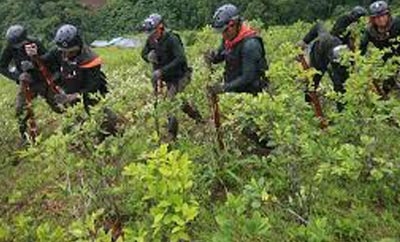Peru has slashed its coca eradication goal in the country’s main coca growing region and backed away from plans for forced eradication, confirming a dramatic policy u-turn it says is in response to the threat posed by the Shining Path guerrillas.
Peruvian Interior Minister Walter Alban has announced the government has reduced its coca eradication goal from 15,000 to 5,000 hectares in the VRAEM region — the Apurimac, Ene and Mantaro River Valleys — where more than half of the country’s 60,000 hectares of coca is grown. Alban also said the government would no longer forcibly eradicate coca, but would instead attempt to meet the new goal through crop substitution.
According to Alban, part of the reason for the government’s change in policy is information that the rebel group the Shining Path, a faction of which operates in the VRAEM region, was offering to help farmers fight eradication, reported Reuters.
In spite of the readjustment in the VRAEM region, Alban said the government would maintain its goal of eradicating a total of 30,000 hectares in Peru this year. He also noted that if locals refused to subscribe to the voluntary eradication plan, the government would return to a policy of forced eradication in the region.
InSight Crime Analysis
Since Humala took office in 2011, his government has changed its tune on coca eradication several times. As a presidential candidate, Humala promised to end forced eradication, but early in his term he appointed pro-eradication Carmen Masias as the head of the National Commission for Development and Life Without Drugs (DEVIDA) to replace the progressive anti-narcotics chief that had initially held the post.
At the start of 2014, Peru announced ambitious plans for record coca eradication, with half of the crops slated for destruction located in the VRAEM. However, the government again changed tack when Humala promised to focus the government’s anti-drug efforts on crop substitution instead of forced eradication then in May dismissed Masias and replaced her with former defense minister Alberto Otarola.
SEE ALSO: Peru News and Profiles
As Alban commented, if they had pushed ahead with plans for forced eradication in the VRAEM, they may well have walked straight into a security crisis. The remaining faction of the Shining Path, which operates in the VRAEM, would likely have helped coca growers resist eradication efforts, both to protect a major revenue source — the guerrillas tax drug production in the area — and to court favor with the poor farmers that grow the coca, who represent a potential political base. The result would likely have been violent confrontations, as have been seen in past eradication campaigns, which would have damaged the government and may well have strengthened the Shining Path.

